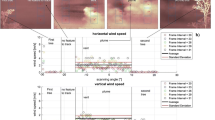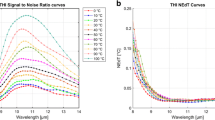Abstract
The ability to image and quantify SO2 path-concentrations in volcanic plumes, either by day or by night, is beneficial to volcanologists. Gas emission rates are affected by the chemical equilibria in rising magmas and a better understanding of this relationship would be useful for short-term eruption prediction. A newly developed remote sensing long-wave thermal InfraRed (IR) imaging hyperspectral sensor – the Thermal Hyperspectral Imager (THI) – was built and tested. The system employs a Sagnac interferometer and an uncooled microbolometer in rapid scanning configuration to collect hyperspectral images of volcanic plumes. Each pixel in the resulting image yields a spectrum with 50 samples between 8 and 14 μm. Images are spectrally and radiometrically calibrated using an IR source with a narrow band filter and two blackbodies. In this paper, the sensitivity of the instrument for the purpose of quantifying SO2 using well constrained laboratory experiments is evaluated, and initial field results from Kīlauea volcano, Hawai’i, are presented. The sensitivity of THI was determined using gas cells filled with known concentrations of SO2 and using NIST-traceable blackbodies to simulate a range of realistic background conditions. Measurements made by THI were then benchmarked against a high spectral resolution off-the-shelf Michelson FTIR instrument. Theoretical thermal IR spectral radiances were computed with MODTRAN5 for the same optical conditions, to evaluate how well the (known) concentration of SO2 in the gas cells could be retrieved from the resulting THI spectra. Finally, THI was recently field-tested at Kīlauea to evaluate its ability to image the concentration of SO2 in a real volcanic plume. A path-concentration of 7150 ppm m was retrieved from measurements made near the Halema’uma’u vent.














Similar content being viewed by others
References
Daag, A.S., Tubianosa, B.S., Newhall, C.G., Tuñgol, N.M., Javier, D., Dolan, M.T., Reyes, P.J.D., Arboleda, R.A., Martinez, M.M.L., Regalado, T.M. (1996). Monitoring sulphur dioxide emission at Mount Pinatubo. [Online] Available at: < http://pubs.usgs.gov/pinatubo/daag1/>, [Accessed on 3 Nov 2014]
Dalton MP, Watson IM, Nadeau PA, Werner C, Morrow W, Shannon JM (2009) Assessment of the UV camera sulfur dioxide retrieval for point source plumes. J Volcanol Geotherm Res 188(2009):358–366
Elias, T., Sutton, A.J. (2012). Sulfur dioxide emission rates from Kīlauea Volcano, Hawai’i, 2007–2010: U.S. Geological Survey Open-File Report 2012–1107, 25 p. (Available at http://pubs.usgs.gov/of/2012/1107/)
Exton, J.R., US National Aeronautics and Space Administration (1976) Stack plume visualization system, U.S. Pat. 3931462
Fellgett PB (1949) On the ultimate sensitivity and practical performance of radiation detectors. J Opt Soc Am (OSA) 39(11):970–976
Francis P, Burton M, Oppenheimer C (1998) Remote measurements of volcanic gas compositions by solar occultation spectroscopy. Nature 396:567–570
Galle B, Oppenheimer C, Geyer A, McGonigle AJS, Edmonds M, Horrocks L (2002) A miniaturized ultraviolet spectrometer for remote sensing of SO2 fluxes: a new tool for volcano surveillance. Journal of Volcanologyand Geothermal Research 119(2002):241–254
Goff F, Love SP, Warren RG, Counce D, Obenholzner J, Siebe C, Schmidt SC (2001) Passive infrared remote sensing evidence for large, intermittent CO2 emissions at Popocatépetl volcano, Mexico. Chem Geol 177:133–156
Goforth MA, Gilchrist GW, Sirianni JD (2002) Cloud effects on thermal downwelling sky radiance. Proc. SPIE 4710, Thermosense XXIV, doi:10.1117/12.459570
Griffith, D. 2012. Matlab class wrapper for Modtran5. Matlab file exchange [online] Available at: <http://www.mathworks.com/matlabcentral/fileexchange/31961-matlab-class-wrapper-for-modtran-5>
Grutter M, Basaldud M, Rivera C, Harig R, Junkerman W, Caetano E, Delgado-Granados H (2008) SO2 emissions from Popocatepetl volcano: emission rates and plume imaging using optical remote sensing techniques. Atmos Chem Phys 8:6655–6663
Horton KA, Williams-Jones G, Garbeil H, Elias T, Sutton AJ, Mouginis-Mark P, Porter JN, Clegg S (2006) Real-time measurement of volcanic SO2 emissions: validation of a new UV correlation spectrometer (FLYSPEC). Bull Volcanol. doi:10.1007/s00445-005-0014-9
Kern P, Werner C, Sutton J, Elias T, Thelen W, Kelly P, Mastin L (2012) Ultraviolet SO2 imaging systems allow insights into degassing processing occurring on short timescales at Kilauea’s summit [Online]. Available at: http://hilo.hawaii.edu/~kenhon/HawaiiChapman/documents/PKern2012HawaiiChapmanPoster.pdf
Kern C, Werner C, Elias T, Sutton AJ, Luebcke P (2013) Applying UV cameras for SO2 detection to distal or optically thick volcanic plumes. J Geophys Res 262:80–89
Kern C, de Moor M, Galle B (2015) Monitoring gas emissions can help forecast volcanic eruptions. Eos 96. doi:10.1029/2015EO034081
La Spina A, Burton M, Allard P, Alparone S, Mure F (2015) Open-path FTIR spectroscopy of magma degassing processes during eight lava fountains on Mount Etna. Earth Planet Sci Lett 413:123–134
Love SP, Goff F, Counce D, Siebe C, Delgado H (1998) Passive infrared spectroscopy of the eruption plume at Popocatépetl volcano, Mexico. Nature 396:563–567
Lucey PG, Horton KA, Williams T (2008) Performance of a long-wave infrared hyperspectral imager using a Sagnac interferometer and an uncooled microbolometer array. Apply Optics 47(28):F107–F113 <7700>
Mertz L (1965) Transformation in optics. Wiley, N.Y
Moffat AJ, Millan MM (1971) The applications of optical correlation techniques to the remote sensing of SO2 plumes using sky light. Atmos Environ 5:677–690
Mori T, Burton M (2006) The SO2 camera: a simple, fast and cheap method for ground-based imaging of SO2 in volcanic plumes. Geophys Res Lett 33:L24804. doi:10.1029/2006GL027916
Mori T, Burton M (2009) Quantification of the gas mass emitted during single explosions on Stromboli with the SO2 imaging camera. Joruanl of Volcanology and Geothermal Research 188:395–400
Noguchi K, Kamiya H (1963) Prediction of volcanic eruption by measuring the chemical composition and amounts of gases. Bull Volcanol 26:367–378
Oppenheimer C, Francis P, Burton M, Maciejewski AJH, Boardman L (1998) Remote measurement of volcanic gases by Fourier Tranform infrared spectroscopy. Applied Physics B Laser and Optics. 67:505–515
Oppenheimer C, Bani P, Calkins JA, Burton MR, Sawyer GM (2006) Rapid FTIR sensing of volcanic gases released by Strombolian explosions at Yasur volcano, Vanuatu. Applied Physics B Laser and Optics 85:453–460
Parfitt E, Wilson L (2008) Fundamentals of physical volcanology. Blackwell Publishing, New York
Prata J, Bernardo C (2014) Retrieval of sulfur dioxide from a ground-based thermal infrared imaging camera. Atmospheric Measurement Techniques 7:2807–2828
Stix J, Gaonac’h H (2000) Gas, plume, and thermal monitoring. In: Sigurdsson H, Houghton BF, McNutt SR, Rymer H, Stix J (eds) Encyclopedia of volcanoes. Academic Press, USA, pp. 1141–1163
Stoiber RE, Jepsen A (1973) Sulfur dioxide contributions to the atmosphere by volcanoes. Science 182:577–578
Stoiber RE, Malinconico JLL, Williams SN (1983) Use of the correlation spectrometer at volcanoes. In: Tazieff H, Sabroux JC (eds) Forecasting volcanic events. Elsevier, New York, pp. 424–444
Swinbank WC (1963) Long-wave radiation from clear skies. Q J R Meteorol Soc 89(381):339–348
University of Wyoming (2016). Upper air daily soundings. [Online]. Available at: < http://weather.uwyo.edu/upperair/sounding.html>
Wallace P, Plank T, Edmonds M, Hauri EH (2015) Volatiles in Magmas. In: Sigurdsson H, Houghton BF, McNutt SR, Rymer H, Stix J (eds) Encyclopedia of volcanoes, 2nd edn. Elseiver, Amsterdam, pp. 168–183
Weibring P, Edner H, Svanberg S, Caltabiano T, Condarelli D, Cecchi G, Pantani L (1998) Monitoring of volcanic sulphur dioxide emissions using differential absorption lidar (DIAL), differential optical absorption spectroscopy (DOAS) and correlation spectroscopy (COSPEC). Appl Phys B Lasers Opt 67:419–426
Weibring P, Swartling J, Edner H, Svanberg S, Caltabiano T, Condarelli D, Cecchi G, Pantani L (2002) Optical monitoring of volcanic sulphur dioxide emissions: comparison between four differemy remote-sensing spectroscopic techniques. Opt Las El 37:267–284
Werner C, Kelly P, Doukas M, Lopez T, Pfeffer M, McGimsey R, Neal C (2013) Degassing associated with the 2009 eruption of redoubt volcano Alaska. JVolcanol Geotherm Res. doi:10.1016/j.jvolgeores.2012.04.012
Williams-Jones, G., Stix, J., Nadeau, P.A. (2008). Using the COSPEC in the field. The COSPEC Cookbook: making SO2 measurements at active volcanoes In: Williams-Jones, G., Stix, J., Hickson, C. (eds.). IAVCEI, Methods in Volcanology 1: 63–119
Wilson L, Walker GPL (1987) Explosive volcanic eruptions VI. Ejecta dispersal in Plinian eruptions: the control of eruptions conditions and atmospheric properties. Geophys J R Astron Soc 89:657–679
Wright R, Lucey P, Crites S, Horton K, Wood M, Garbeil H (2013) BBM/EM design of the thermal hyperspectral imager: an instrument for remote sensing of earth’s surface, atmosphere and ocean, from a microsatellite platform. Acta Astronautica 87:182–192
Acknowledgments
Funding for this work was provided by NASA’s Earth Science Technology Office (Instrument Incubator Program, NNX14AE61G). We thank the United States Department of Interior National Parks Service for authorizing collection of the field data reported in this paper (Permit number HAVO-2015-SCI-0050). This is HIGP publication number 2224 and SOEST publication number 9720.
Author information
Authors and Affiliations
Corresponding author
Additional information
Editorial responsibility: T.P. Fischer
Rights and permissions
About this article
Cite this article
Gabrieli, A., Wright, R., Lucey, P.G. et al. Characterization and initial field test of an 8–14 μm thermal infrared hyperspectral imager for measuring SO2 in volcanic plumes. Bull Volcanol 78, 73 (2016). https://doi.org/10.1007/s00445-016-1068-6
Received:
Accepted:
Published:
DOI: https://doi.org/10.1007/s00445-016-1068-6




